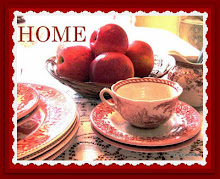
There are quite a number of words in the English language that I find very evocative, two of them are Tudor and stillroom - put them together and I am transported to another world filled with the scents of roses, herbs and spices, where gentlewomen and their maids used skills and recipes learned over centuries and passed on from one generation to the next. I think that monasteries were the first places to have herb gardens where they grew herbs which were used to prepare medicines for treating the sick and they had dispensaries and stillrooms. Readers of Ellis Peters' Cadfael novels will be familiar with this. With the dissolution of the monasteries by Henry VIII in 1546 this free medical service disappeared and the Lady of the Manor began to take on the task of preparing medicines for her household. The stillroom would already have been in use for distilling aromatic waters, preserving, making cosmetics (some of which were pretty lethal!), drying herbs for winter use and for strewing herbs which were used for pest control. To this was now added the preparation of ointments, cough linctus, rubbing oils for rheumatic joints and so on.
The photo at the top is of Tina, our tutor, gathering herbs in the garden at Bayleaf Tudor farmstead.

The results of her labours - by no means all herbs would be grown in the garden of course, many would be gathered from the lanes around the village - elder, hawthorn, cleavers, nettles, cowslips among them. Gathering herbs is such a pleasurable occupation, so many of them have wonderfuls scents, roses, various mints, lemon balm, rosemary, southernwood(opinions differ here, I love southernwood but not everyone does, it has a slightly musky edge to the lemon scent). Then there are the beautiful colours of the roses, pot marigolds, hyssop, borage and many others.

The contents of the basket were added to the herbs that Tina had gathered and brought from her own garden. One thing I've realised is that a simple jug filled with a mixture of herbs is a very attractive sight, perfect for a kitchen windowsill or anywhere else for that matter.

The start of a healing ointment - extra virgin olive oil with a selection of herbs including ribwort plantain, pot marigold petals, thyme, marshmallow, scarlet pimpernel and fumitory. This is put to heat gently for 3 or 4 hours then strained and melted beeswax added. At this point speed is required to pour it into small dark glass jars as it starts to set incredibly quickly.

If you don't have any muslin to strain it through no problem - you go out and gather a large bunch of cleavers, make two circles put one on top of the other lying in opposite directions and hey presto! or abracadabra or whatever you wish to say:) It works extremely well too.

Not everything that is made in the stillroom is purely for usefulness, some are decorative such as the various flower sugars. This is one of the ladies taking a turn at pounding marigold petals into sugar - quantities are simple,one cup of petals to one cup of sugar. I have to say that one or two members of the class, including this lady had obviously not used a mortar and pestle before. It requires a rather more robust action than this I'm afraid :)

We also used rose petals and this is the rose sugar spread out on greaseproof paper to dry. When it's dry you store it in an airtight glass jar and use it to decorate cakes - and very pretty too. The sugar retains the scent of the roses so has a wonderful flavour as well as a pretty colour.

These are the flowers of rosa gallica officinalis otherwise known as the Apothecary's Rose. The scent is divine and the uses are surprisingly varied - rose petal jelly, the rose sugar, candied rose petals, rosewater, rose honey and, of course, pot pourri.

Before using the petals they need to have the white heel at the base cut off and then to be washed and dried. Here they are spread out on muslin to dry.

This is another use for the rose and marigold sugars - people in Tudor times loved sweet things and the shape was made using the sugars mixed with rosewater and gum tragican. The rose and marigold are done individually, rolled into thin sausage shapes and then plaited together. After this they are sliced into rounds and left to dry out and the finished product looks very pretty.
Finally I have to bring to your attention Peppermint Liqueur. I can only say that if you have never tasted this you haven't lived!! It is so simple to make and the result is out of this world but unfortunately you have to wait two years for it to mature properly:( This is Tina Stapeley's recipe from her lovely book Herbcraft Naturally. You need 1 bottle of brandy, a cup of roughly chopped or torn peppermint leaves, a cup of roughly chopped or torn lemon balm leaves, 1/2 tspn of dill seeds and 1/2 tspn of cinnamon. Use only perfect undamaged leaves, wash and dry them and add them to the brandy. The leaves don't need to be chopped that small, you are simply trying to release the flavour. Pound the dill seeds in a mortar, grind enough of a cinnamon stick to produce 1/2 tspn of powder and add them to the brandy and herbs. Screw on the top of the bottle or jar tightly, give a good shake then store it in a warm,dark place for 6 weeks, give it a gentle shake each day. After 6 weeks filter it through a paper coffee filter into a clean bottle or jar and add about a cup of sugar. The exact amount varies according to personal taste. Now comes the hard bit - put it away in a cupboard and forget about it for at least 18 months, preferably 2 years. The wait will be worth it. It's medicinal too as it's a good remedy for indigestion! Only a liqueur glassful at a time please:)































